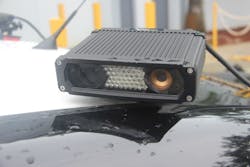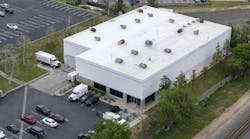Law enforcement agencies are always looking for more information on what is happening on the streets they patrol. Municipalities only have so many officers to patrol their communities, so they are beginning use CCTVs to give themselves more eyes.
The City of Hollywood, Fla., is one such agency embarking on a major program to update its technology in the fight against crime.
Hollywood Police Department is in the initial phases of a $1.5 million CCTV camera program. The city plans to install 12 CCTVs along North Beach, 26 CCTVs along Federal Highway and four in the downtown section. Eventually there will be six more phases of the CCTV camera program in the western sections of Hollywood. There are now two CCTVs in use; the other cameras will be installed as soon as the permitting process is complete.
Hollywood is also utilizing license plate readers throughout the city. The 14 license plate readers currently in use will allow police to see vehicles entering the city that have been involved in illegal activity. For example, if a car has been reported stolen the license plate reader will show police that the stolen car has entered Hollywood. If the car of a person wanted for a crime enters Hollywood, police will be notified when the car enters the city. If a car driven by person who is not to be near a school is considered too close to a school, the license plate reader will pick that up.
The CCTV cameras will show police what is taking place in certain areas of the city. For example, if an armed robbery occurs at a gas station, the camera will show police that a crime has occurred. If the robber leaves the scene in a car, the license plate reader will pick up the license plate of the thief as he or she escapes the area, and police can be dispatched to pursue the vehicle.
Each camera is a force multiplier and is the equivalent of ten police officers. Police are essentially setting up a geofence around the outer perimeter of Hollywood.
When a known criminal enters the city, police will capture their license plate and that information becomes an investigative tool for detectives. “We are averaging about three to four arrests a day involving stolen cars, robberies, burglaries and other violent crimes since we started this program. It provides more eyes for our officers. One officer can view ten cameras at a time,” said Hollywood Detective Daniel Justus.
Information collected from the CCTVs and license plate readers is fed into the crime intelligence center at police headquarters. There are 24 televisions inside the center that can be monitored by three officers. This system allows the police to track crime trends in Hollywood and predict where future criminal activity may occur.
“I believe it is good for the residents and business owners of Hollywood because it reduces crime,” says Justus.
The Florida Department of Transportation has awarded a $7.9 million contract to SICE Inc. to install Advanced Traffic Management System technology to identify and respond to the causes of congestion in real time on various roadways in Palm Beach and Broward counties. Construction has begun and will be completed by spring 2016.
Forty-three CCTV cameras will monitor traffic throughout areas with significant traffic. These cameras are produced by GovComm and provide versatile video management software for remote live viewing, playback and video clip back-up. They will feed directly into the traffic management center in Broward County, and staff will review the cameras and dispatch emergency personnel to the scene of an accident. The department also plans to install nine Arterial Dynamic Message Signs to display traveler information such as information on crashes and roadway conditions and safety messages for drivers. A total of 17 Arterial Travel Time Systems will collect travel time data and the installation of two Microwave Vehicle Detection System sensors to monitor traffic volume and speed detection. The department also plans to update and integrate 13 existing Permanent Traffic Management Cabinet sites along the corridor.
“This will allow drivers to have access to real time information while they are traveling busy corridors in South Florida,” says Casey Liening, a consultant public information officer for the Florida Department of Transportation.
Fort Lauderdale PD is in the process of installing wireless cameras in the beach area and a downtown section of the city. Fort Lauderdale’s Detective Karl Maracotta says, “We believe these cameras will allow us to see more of what is taking place and collect data. The beach is a high traffic area with a lot of tourists.”
The Fort Lauderdale PD is using WildFire Camera Networks and hopes the cameras will provide a better view of the city’s busiest areas. WildFire is a wireless video-surveillance camera company that specializes in designing, building and managing city-wide and county-wide high-speed wireless camera networks for municipal governments and their law enforcement and emergency response agencies.
These wireless networks enable WildFire’s low-cost, high resolution wireless video surveillance cameras to be deployed almost anywhere in a city or county, while being connected back to a single, centralized Network Video Recorder located at the agency’s central dispatch location. There personnel can monitor and record the video at the highest possible video-quality level, according to WildFire’s website.
Samsung case studies
The tech giant Samsung has also presented some case studies on the value of CCTVs in communities. Houston has developed an area known as GreenStreet, a mixed use center. The new owners, Midway and Canyon Johnson Urban Funds—which is co-owned by Magic Johnson—wanted to create a pleasant, pedestrian oriented space with a linear park in the center corridor that could be used to stage events. Because of the large crowds coming to the area and a nearby convention center, there was a need for more security but there was a need to keep the area friendly, too.
Before the renovations, GreenStreet’s surveillance system included limited cameras and DVRs without any system management capabilities. The system also lacked sufficient coverage, which drained productivity as security personnel were called on to manually open and close bay doors for vendors and delivery drivers. The area’s property owners wanted a system upgrade. Working with Houston-based Today’s Integration Inc., GreenStreet selected Samsung Techwin as the video surveillance solutions provider. Howard Manson, CEO of Today’s Integration says, “The decision was based on the quality, functionality, versatility and expandability of Samsung’s products.”
Today’s Integration designed an advanced video surveillance solution built on Samsung Security Manager (SSM) video management software. This allows GreenStreet’s security staff to monitor live and recorded video, control PTZ cameras and communicate via two-way audio from a central command center. The system employs multiple Samsung 5080R IP dome cameras, SNP-5200H PTZ dome cameras and 6084R fixed cameras. The system’s NVRs are located in a server room and are connected directly to cameras for recording and to SSM for video playback. Video is transmitted across GreenStreet’s network via hybrid fiber, connecting the multi-site buildings to distribution switches, which also provide PoE to the Samsung cameras (implemented by Today’s Integration Inc.).
Today’s Integration utilized SSM as the foundation of a solution deployed specifically to eliminate the inefficient process of physically opening bay doors by installing dome cameras inside and outside the bay doors with intercom boxes on the exterior. Today’s Integration designed controls that remotely open and close doors using the camera’s relay outputs and inputs. “By allowing security staff to remotely view and interact with individuals requesting access to bay doors, SSM has saved GreenStreet a great deal of time and money and has eased the burden placed on security staff,” said Manson.
The study also claims that the system has helped the Houston PD, which requests video for resolving incidents, tracking vagrancy, and other public safety matters.
CCTVs were also effective in dealing with crime in Pittsburgh, Penn. The city’s Housing Authority (HACP) was having problems with unreported shootings and other crimes. Edward Mauk, a leader of the Housing Authority with 290 employees and 10,000 residents and other leaders came together to invest in a large security system that would offer stronger legal evidence and the ability to audit maintenance and security office tours.
“As a housing authority we are very concerned about our sites. We had several cameras installed that we were hodge-podging together, if you will ... and trying to some kind of coverage. We wanted to network all of the cameras, get full coverage of all our sites, and have a control center where we can monitor it. We weren’t satisfied with what we had on our own,” Mauk was quoted as saying. “The disparate array of pan-tilt-zoom cameras were often pointed in the wrong direction, producing evidence that could not be used in the prosecution of crimes committed on public housing property, and residents were often afraid to report crime. Our vision from the start was to set up a state-of-the-art video surveillance system.”
Through its partnership with Samsung, HACP installed 900 cameras in 18 locations. Each camera is either pan-tilt-zoom or a megapixel (1.3 to 3 MP) in order to get high quality forensic evidence of crimes. The basic infrastructure consists of IP cameras that are powered over Ethernet (PoE) with feed going directly into a local server-based NVR. The video can then be viewed using a Milestone VMS platform within the command center in downtown Pittsburgh. The VMS system displays a composite of images from the server, not the cameras themselves, which allows the system to run smoothly without interrupting video feeds. Fiber was run to every location in order to maintain consistent and rapid transmission speeds, according to Larry Shank, management information systems director for HACP, in the Samsung case study report.
Now almost every light pole has a camera and some have three. Streets in the Housing Authority neighborhoods have cameras observing every corner. Community spaces such as playgrounds are monitored, but the equipment is not obvious. They are small dome-type cameras and installed high up. Through this system, HACP employees can quickly pull up evidence whenever law enforcement personnel call with an incident report. The HACP is also beta-testing many other features through Samsung, including motion and sound detection, automatic tracking and facial detection, according to the case study report.
It appears likely that more police agencies and housing organizations will be using camera technology more comprehensively in the future. Many police chiefs and public service administrators consider the cameras to be a force multiplier and a very effective crime fighting tool.



